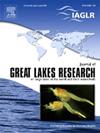Age-dependent juvenile mortality explains delayed smolting in a declining steelhead population
IF 2.4
3区 环境科学与生态学
Q3 ENVIRONMENTAL SCIENCES
引用次数: 0
Abstract
Fish populations in the Laurentian Great Lakes have undergone major changes over recent decades. Demographic changes in fish populations are often accompanied by changes in life history strategies that reflect variation in mortality applied to different life stages. We examined the steelhead (Oncorhynchus mykiss) population in Black Bay, Lake Superior, where a naturalized steelhead population experienced significant demographic changes over three decades. Initial increases in density in Portage Creek, Black Bay (1995–2007) were associated with reductions in angler mortality (applied to adult steelhead), but the population declined (2007–2018) despite no further changes in angler mortality. Simultaneously, the dominant life history among several Black Bay tributaries changed between 2013 and 2017, with returning spawners becoming primarily represented by individuals who smolted at age 2 (a more common pattern across other Lake Superior populations) from those who primarily smolted at age 1. To assess whether changes in juvenile mortality could explain observed life history shifts in surviving spawners and recent steelhead population declines, we constructed Leslie matrices with differential mortality applied to observed demographics from Portage Creek steelhead to evaluate scenarios representing increased parr (in-stream) mortality and increased smolt (in-lake) mortality. The observed demographic changes in Portage Creek (i.e., shift from 1 to 2 year smolts and associated population declines) were predicted by a model applying size-dependent smolt survivorship to female steelhead in a fashion consistent with increased in-lake mortality of age 1 smolts. This study provides an example of population-level responses to increased stage-specific mortality and offers an example of how in-lake conditions can influence potamodromous salmonids in the Laurentian Great Lakes.
受年龄影响的幼鱼死亡率解释了钢镞种群数量下降的延迟蜕皮原因
近几十年来,劳伦森五大湖的鱼类种群发生了重大变化。鱼类种群的人口变化往往伴随着生活史策略的变化,这些变化反映了不同生命阶段死亡率的变化。我们研究了苏必利尔湖黑湾的steelhead (Oncorhynchus mykiss)种群,在那里,一个归化的steelhead种群在过去的30年里经历了显著的人口变化。黑湾Portage Creek的密度最初增加(1995-2007年)与垂钓者死亡率降低(适用于成年钢头鱼)有关,但种群数量下降(2007-2018年),尽管垂钓者死亡率没有进一步变化。与此同时,2013年至2017年期间,黑湾几条支流的主导生活史发生了变化,回归的产卵者主要由2岁时孵化的个体(在其他苏必利尔湖种群中更常见的模式)从1岁时孵化的个体转变为2岁时孵化的个体。为了评估幼鱼死亡率的变化是否可以解释观察到的存活产卵者的生活史变化和最近的钢头数量下降,我们构建了Leslie矩阵,将差异死亡率应用于观察到的Portage Creek钢头的人口统计数据,以评估幼鱼(流内)死亡率增加和幼鱼(湖内)死亡率增加的情景。观察到Portage Creek的人口变化(即从1岁到2岁的小鲑鱼和相关的种群下降)是通过一个模型来预测的,该模型将大小依赖的小鲑鱼存活率应用于雌性钢头鱼,其方式与1岁小鲑鱼在湖中的死亡率增加一致。本研究提供了一个例子,说明了种群水平对特定阶段死亡率增加的反应,并提供了一个例子,说明了湖内条件如何影响劳伦森五大湖的鲑鱼。
本文章由计算机程序翻译,如有差异,请以英文原文为准。
求助全文
约1分钟内获得全文
求助全文
来源期刊

Journal of Great Lakes Research
生物-海洋与淡水生物学
CiteScore
5.10
自引率
13.60%
发文量
178
审稿时长
6 months
期刊介绍:
Published six times per year, the Journal of Great Lakes Research is multidisciplinary in its coverage, publishing manuscripts on a wide range of theoretical and applied topics in the natural science fields of biology, chemistry, physics, geology, as well as social sciences of the large lakes of the world and their watersheds. Large lakes generally are considered as those lakes which have a mean surface area of >500 km2 (see Herdendorf, C.E. 1982. Large lakes of the world. J. Great Lakes Res. 8:379-412, for examples), although smaller lakes may be considered, especially if they are very deep. We also welcome contributions on saline lakes and research on estuarine waters where the results have application to large lakes.
 求助内容:
求助内容: 应助结果提醒方式:
应助结果提醒方式:


